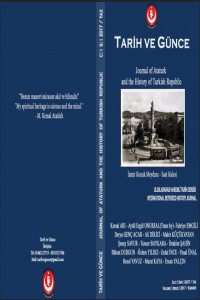The Impact of the Migration of the Spatial Texture Change in Cities, and This Has Created Problems in Terms of Turkish Cinema
Öz
Turkey from the 1950s has entered into a quick
process of change. "Little America" set out with dreams of
becoming exit this year, stripped the country's existing agricultural non
process identity to enter quickly. So to become mechanized of agriculture
and increasing industrialization in the cities from villages along the right,
there was an intense migratory movement. Istanbul has a privileged
position in that sense. Indeed, in parallel with the increase in
industrialization of the city from the rural areas to work in factories has
taken an intensive migration. The city's lack of this migration request
respond yet situation slum called crooked urbanisation. In addition, also
be social memory erosion identity that represents the many buildings or the
fate of abandoned or demolished for the opening of the apartment or
streets. In this sense social transformation he went with urban
transformation.
Cinema in the 1950s in parallel with changing social and economic change is
an art. The last time a sense of Visual memory that serves as a cinema
that is present in the Exchange. Turkish cinema of the 1950s, then stop
and stand on their own two feet to move him more freedom has given way
institutionalization. So there's the structure of Turkish cinema has been
a way to the opposition at the same time. In this study, we present the
dimensions of social change in the scale of the cinema will be explained
through İstanbul. Here the most important films from among today's still
"Gurbet Birds" and "Oh Beautiful İstanbul" movies over the
social transformation and the spatial dimension of corruption.
Anahtar Kelimeler
Kaynakça
- Birgun, 18.08.2016.
- BOSTAN, Mesut, “Oh Lovely Istanbul and Urban Conservatism”, Research on Turkis Cinema, www.tsa.org.tr.
- CEYHAN, Muge, Protection of Historical Environment in Istanbul and Press: “An Essay via Newspaper Cumhuriyet”, ITU Institute of Positive Sciences Master’s Degree Thesis, June 2006.
- CAVDAR, Tevfik, “Social Impacts of Unemployment”, Republic Period’s Turkey Encyclopedia, V: 5, Iletisim Publications, Istanbul.
- ERTEM, Baris, Mustafa Cevdet Altunel, “Study of Loss of Historical Works in the Development of Istanbul from the Perspective of History and Tourism: Karakoy-Kabatas Area”, ODU Institute of Social Studies Social Studies Research Magazine, Volume: 2, Issue: 4, December 2011.
- ERKILIC, Senem, Duruel, “Cinema and Music as a Representation of Chanhges in Social Acclaim: Oh Lovely Istanbul, Muhsin Bey and Where Are You, Firuze”, Galatasaray University Communication Magazine, Issue: 8, 2008, p. 130, www.iletisimdergisi.gsu.edu.tr.
- EVREN, Burcak, “Movements, Trends and Outbreaks in Our Cinema” Life Changing, Man Changing in 75 Years Republican Trends, History Foundation Publications, Istanbul, 1999.
- FILMER, Cemil, Memoirs, Emek Printing House, Istanbul, 1984.
- GUCHAN, Gulseren, Social Change and Turkish Cinema, Imge Publishing House, Ankara, 1992.
- GURESCI, Ertugrul, “Reflection of Rural-Urban Immigration on Rural and Urban Areas: An Evaluation on Akpinar Village”, Social Studies and Humanities Magazine, V: 2, Issue: 2, 2010.
- GERAY, Cevat, Rusen Keles, Fehmi Yavuz, Can Hamamci, “Urbanism”, Republic Period’s Turkey Encyclopedia, V: 9, Iletisim Publications, Istanbul.
- KAYALI, Kurtulus, To Try to Read Metin Erksan’s Movies, Dost Publishing House, Ankara, 2004.
- KAZGAN, Gulten, “Agriculture”, Republic Period’s Turkey Encyclopedia, V: 9, Iletisim Publications, Istanbul.
- KEPENEK, Yakup, “Industrialisation Processes of Turkey”, Republic Period’s Turkey Encyclopedia, V: 7, Istanbul.
- KOCAK, Yuksel, Elvan Terzi, “Immigration Phenopmenon in Turkey, Effects of Immigrants on Urban Areas and Proposals for Solution”, KAU-IIBF Magazine, Volume: 3, Issue: 3, 2012, pp. 164-166, www.iibfdergi.kafkas.edu.tr
- KONGAR, Emre, Turkey in the 21st Century, Remzi Publishing House, Istanbul, 2005.
- KUBAN, Dogan, “A Significant Part of the Historical Environment Disappears in Istanbul”, Mimarlik, Issue: 10, 1965, p. 21, www.mimarlıkdergisi.com
- ORMANLAR, Çagla, “Liberalisation Brought by Social Mobility 1970-80”, Life Changing, Man Changing in 75 Years Republican Trends, History Foundation Publications, Istanbul, 1999.
- OZER, Inan, “City, Urbanisation and Urban Change in Turkey”, Turkey’s Social Structure from Past to Present, Editor: Memet Zercirkıran, Nova Publications, Istanbul, 2006.
- OZON, Nijat, History of Turkish Cinema (1896-1960), Doruk Publishing, Istanbul, 2010.
- PISKIN, Gunseli, “Immigration in Turkey and Its Reflections in Turkish Cinema: 1960-2009”, NWSA, January, 2010, Issue: 1, www.newwsa.com
- SAHIN, Cigdem, “Istanbul Is Becoming a Decor”, Mimarlik, November-December 2010, Issue: 356, www.mimarlıkdergisi.com
Ayrıntılar
| Bölüm | Makaleler |
|---|---|
| Yazarlar | |
| Yayımlanma Tarihi | 14 Temmuz 2017 |
| Gönderilme Tarihi | 30 Temmuz 2017 |
| Yayımlandığı Sayı | Yıl 2017 Cilt: 1 Sayı: 1 |
Kaynak Göster
Yayının Türü: Uluslararası Akademik Hakemli-Altı Ayda Bir Yayınlanır


